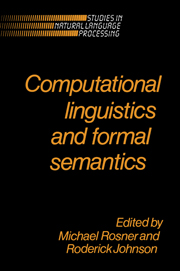Book contents
- Frontmatter
- Contents
- List of contributors
- Preface
- 1 Unification
- 2 Representations and interpretations
- 3 Syntactic categories and semantic type
- 4 Fine-structure in categorial semantics
- 5 Properties, propositions and semantic theory
- 6 Algorithms for semantic interpretation
- 7 Situation schemata and linguistic representation
- 8 Application-oriented computational semantics
- 9 Form and content in semantics
- 10 Epilogue: on the relation between computational linguistics and formal semantics
- Bibliography
8 - Application-oriented computational semantics
Published online by Cambridge University Press: 05 June 2012
- Frontmatter
- Contents
- List of contributors
- Preface
- 1 Unification
- 2 Representations and interpretations
- 3 Syntactic categories and semantic type
- 4 Fine-structure in categorial semantics
- 5 Properties, propositions and semantic theory
- 6 Algorithms for semantic interpretation
- 7 Situation schemata and linguistic representation
- 8 Application-oriented computational semantics
- 9 Form and content in semantics
- 10 Epilogue: on the relation between computational linguistics and formal semantics
- Bibliography
Summary
INTRODUCTION
Large practical computational-linguistic applications, such as machine translation systems, require a large number of knowledge and processing modules to be put together in a single architecture and control environment. Comprehensive practical systems must have knowledge about speech situations, goal-directed communicative actions, rules of semantic and pragmatic inference over symbolic representations of discourse meanings and knowledge of syntactic and phonological/graphological properties of particular languages. Heuristic methods, extensive descriptive work on building world models, lexicons and grammars as well as a sound computational architecture are crucial to the success of this paradigm. In this paper we discuss some paradigmatic issues in building computer programs that understand and generate natural language. We then illustrate some of the foundations of our approach to practical computational linguistics by describing a language for representing text meaning and an approach to developing an ontological model of an intelligent agent. This approach has been tested in the dionysus project at Carnegie Mellon University which involved designing and implementing a natural language understanding and generation system.
SEMANTICS AND APPLICATIONS
Natural language processing projects at the Center for Machine Translation of Carnegie Mellon University are geared toward designing and building large computational applications involving most crucial strata of language phenomena (syntactic, semantic, pragmatic, rhetorical, etc.) as well as major types of processing (morphological and syntactic parsing, semantic interpretation, text planning and generation, etc.). Our central application is machine translation which is in a sense the paradigmatic application of computational linguistics.
- Type
- Chapter
- Information
- Computational Linguistics and Formal Semantics , pp. 223 - 256Publisher: Cambridge University PressPrint publication year: 1992
- 4
- Cited by

